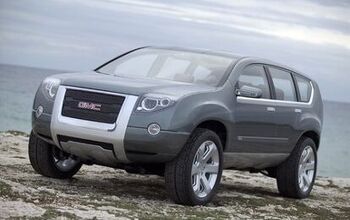General Motors Death Watch 137: The General Dumps Allison
“This is another important step to strengthen our liquidity and provide resources to support our heavy investments in new products and technology.” And so General Motors' CEO Rick Wagoner heralded the sale of GM's Allison Transmission unit for $5.6b. Odd that. Allison has provided General Motors with new products and technology for eight decades, and billions upon billions of dollars in revenue. So is this another case of GM throwing its furniture into the fire to heat the house? You betcha.
Allison Transmission began life as the Indianapolis Speedway Team Company in 1915, fabricating quality parts for America's burgeoning automotive industry. In the roaring 20’s, Allison successfully applied its engineering and manufacturing skills to military airplanes (e.g. high-speed reduction gears for aircraft motors and propellers and Roots-type blowers).
When the company’s founder died in 1929, General Motors added Allison to its corporate portfolio. Since then, Allison has been at the forefront of its field, from the 1947 V-drive transmission to the Vietnam-era M551 tank to its new “world transmission.”
The company still focuses its energies on designing and producing automatic transmissions for trucks, buses, off-highway equipment and military vehicles. Allison's excellence has earned the company an 80 percent market share for medium- and heavy-duty commercial transmissions.
That expertise now belongs to The Carlyle Group and Onex Corp. The former is a private equity firm deeply involved in military contracts; the latter is a Canadian conglomerate with their mitts in everything from airplanes to makeup.
The new owners get Allison’s global sales and distribution network and seven (out of eight) manufacturing facilities. GM retains the Baltimore plant, which makes, amongst other things, hybrid drivetrains.
Allison’s two-mode hybrid system has been a huge commercial success. The system marries an internal combustion engine to a hybrid transmission: two electric motors/generators inside an infinitely variable transmission. With a nest of nickel metal hydride batteries, a vehicle using the Allison system can drive under electric power, combustive force or an adjustable combination thereof.
Buses with Allison’s hybrid system schlep passengers in Seattle, Philadelphia, Minneapolis, Portland, Salt Lake City, Austin, Hartford, Houston and 38 more U.S. cities and parks (e.g. Yosemite). The hybrid-equipped vehicles achieve some 50 percent better fuel economy than diesel-only drivetrains.
The system also reduces emissions: nitrous oxides (50 percent), particulate matter(90 percent), carbon monoxide (90 percent), hydrocarbons (90 percent) and cardon dioxide (50 percent). Allison’s parallel hybrid electric system is quieter than its peers and faster off the line. And it's both scalable and adaptable; it can be fitted to nearly any size vehicle, front or rear wheel-drive.
Before The General off-loaded Allison, GM Powertrain’s group vice president proudly declared Allison’s handiwork “the most efficient hybrid architecture available in the world today.”
At the time, Tom Stephens also promised that “Our Allison Electric Drive System will help establish hybrid technologies as effective, practical and commercially viable beyond mass transit applications."
Hence GM’s retention of the Baltimore plant, where Allison is adapting their hybrid system to the automaker’s GMT-900-based SUVs. The Allison divestiture ought not interfere with the implementation of this program.
That said, the final decision on who gets what patents or rights to Allison’s hybrid technology is likely thousands of billable hours away. The future of GM's two-mode hybrid co-development partnership with Chrysler and BMW is also an open question.
Meanwhile, GM is exchanging Allison’s enormous potential in a growing field– and a not inconsiderable $2b annual turnover– for an immediate $5b cash injection. You could say it’s the bird-in-the-hand thing. But putting down your leg up on hybrid know-how seems more like a biting-off-and-swallowing-the-hand-that-feeds-you kind of thing.
Some analysts have lauded the Allison sell-off, claiming it brings GM's management team "closer to their core business.” That sort of spin is almost believable when referencing The General's decision to sell off half of its GMAC finance unit to the ravenous three-headed dog. But when you’re talking transmissions, the spin stops here. What’s more at the heart of an automobile manufacturer than the greasy bits that make the vehicles, you know, motive?
You don’t have to look too hard at the Allison sale to see that it reeks of desperation. There’s only one reason GM sold Allison: cash. There are only two possible motives. Either GM’s roasting in a cash conflagration or Rick Wagoner’s telling it like it is: the company is building-up a war chest to invest in the kind of new technology they just sold. Occam’s razor that.
More by Michael Martineck
Latest Car Reviews
Read moreLatest Product Reviews
Read moreRecent Comments
- El scotto Dale Carnegie had his grandkids do some upgrades?
- El scotto Work it backwards. How many people use Tesla Super Chargers: Primary Charging Point - this is my normal charging station; Secondary charging station - at a retail location or planned on trips, Rarely or Not at All.
- FreedMike Some clarification would make sense here: Tesla is laying off the team responsible for BUILDING NEW Supercharger stations. Apparently the ones already being built are going to be completed. The folks who maintain the current network are apparently unaffected. https://www.nytimes.com/2024/04/30/business/tesla-layoffs-supercharger-team.htmlAlso, many other other manufacturers are switching to NACS in the upcoming years, and some of those companies are already providing Supercharger adaptors for their non-NACS vehicles. Some Superchargers can already accomodate non-Tesla vehicles with a built in adaptor called the "magic dock."Given all this, my guess? They're trying to maximize utilization of the current system before building it out further.
- Dartman Damn Healey! You can only milk a cow so many times a day! Don’t worry though I bet Flex, 28, 1991, and all the usual suspects are just getting their fingers warmed up!
- FreedMike Your Ford AI instructor:


































Comments
Join the conversation
Allison is small potatos. Production is low, geared to the truck market, not the auto market. Makes sense to sell it. (GM kept the plant making mass market Allison Transmissions).
I agree the plunge protection team is all that is holding the stock up. Completely legal. When the time comes, fortunes will be made shorting GM stock. I should have retired when Dana plunged. Their stock died in one year. GM will go much quicker once the PPT pulls the plug.